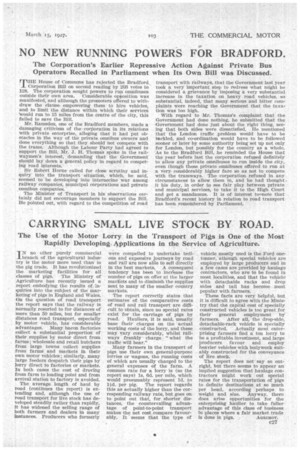CARRYING SMALL LIVE STOCK BY ROAD.
Page 49

If you've noticed an error in this article please click here to report it so we can fix it.
The Use of the Motor Lorry in the Transport of Pigs is One of the Most Rapidly Developing. Applications in the Service of Agriculture.
IN no other purely commercial branch of the agricultural industry is the motor more used than in the pig trade. It has revolutionized the marketing facilities for all classes of pigs. The Ministry of Agriculture has recently issued a report embodying the results of Inquiries into the subject of the marketing of pigs in England and Wales. On the question of road transport the report says that the railway is normally resorted to for distances of more than 50 miles, but for smaller distances road transport, especially by motor vehicle, has considerable advantages. Many bacon factories collect a substantial proportion of their supplies by motor direct from farms ; wholesale and retail butchers from large towns collect supplies from farms and markets in their own motor vehicles; similarly, many large feeders despatch their pigs by lorry direct to factories or markets. Ra both cases the cost of droving from farm to loading point and from arrival station to factory is avoided.
The average length of haul by road (continues the report) is extending and, although the use of road transport for live stock has developed steadily rather than rapidly, It has widened the selling range of both farmers and dealers in many instances. Producers who formerly were compelled to undertake tedious and expensive journeys by road and rail are now able to sell directly in the best markets. A consequent tendency has been to indease the number of pigs on offer at the larger markets and to diminish the supplies sent to many of the smaller country markets.
The report correctly states that estimates of the comparative costs of road and rail transport are difficult to obtain, since no special rates exist for the carriage of pigs by road. Hauliers, it is said, usually base their charges on the actual working costs of the lorry, and these may vary considerably, whilst railways frankly charge "what the traffic will bear."
Many farmers in the transport of pigs use their own general-purpose lorries or wagons, the running costs of which are usually charged to the general expenses of the farm. A common rate for a lorry is (so the report says) 1s. 6d. per mile, which would presumablyrepresent 1d. to 1id. per pig. The report regards this as actually higher than the corresponding railway rate, but goes on to point out that, for shorter distances, the countervailing advantage of point-to-point transport makes the net cost compare favourably. It seems that the type of
vehicle mostly used is the Ford onetonner, athough special vehicles are employed by large producers and in a few, cases are provided by haulage contractors, who are to be found in most localities, and that the vehicle with detachable racks and drop sides and tail has become most popular with farmers.
These facts are very helpful, but It is difficult to agree with the Ministry that the capital cost of specially constructed vehicles is too great for their general employment by farmers. After all, the drop-side, detachable-rack vehicle is specially constructed. Actually most enterprising farmers find a ton lorry to he a profitable investment, and large producers favour and employ heavier vehicles with bodywork suitably constructed for the conveyance of live stock.
The report does not say so outright, but there seems to appear an implied suggestion that haulage contractors might work out special rates for the transportation of pigs to definite destinations at so much per head, according perhaps to weight and size. Anyway, there does arise opportunities for the enterprising Muller to take fuller advantage of this class of business in places where a fair market trade is done in pigs. AGRIAIOT.












































































































